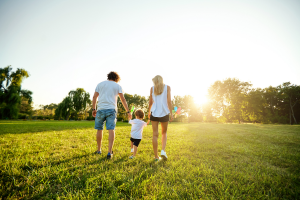As a working caregiver, time is a precious commodity and convenience is your friend. How can you improve your eco credentials while managing the juggle?
Here’s some inspiration for ways to cut down your waste footprint without increasing your mental load.
David Attenborough and his Blue Planet TV series probably did more for the health of the oceans than decades of government legislation. Once the second series aired in 2018, awareness of plastic pollution skyrocketed and the topic darted up the discussion agenda in parliaments and living rooms alike.
Knowing what needs to be done about the environment and having the ability to act on it, though, can feel like two very different things. When you’re a busy working caregiver, fitting in a trip to the organics store after work to pick up zero-waste groceries, or walking to every meeting instead of taking the car, feels like an impossible task. To many of us, the mantra ‘Everyone’s fed, no one’s dead’ signifies a successful day.
Convenience versus the environment
It’s fair to say, the commodity that working families probably have the least of is time. To claw this back, we often opt for convenience — which is rarely good for the environment.
And yet, becoming a caregiver makes us more environmentally aware. In an April 2008 poll, 91% of respondents said that having a child was the primary motivation for protecting the environment, saying the most important reason to recycle was the impact on their children’s future.
From working parent to eco-parent
Not only do we want to leave the planet in a better state for our children, but we also want to role model the kinds of behaviors we hope future generations will adopt.
In the trade-off between convenience and the environment, how can working caregivers lighten their footprint on the planet, whilst still managing the juggle?
1. Buy or borrow pre-loved items for your children
There are many benefits to buying kids’ clothes, toys, and accessories in a secondhand sale. You can get everything you need in one place, at incredible discount prices. There’s no need to traipse around a shopping center or mall from store to store, paying retail prices.
I love these sales — I usually find a stallholder with items for a similar-aged child and buy up a bulk of their pre-loved clothes and toys. You can also talk through the items with people who have actually used them, so you’re getting real opinions from other parents.
When it comes to essential equipment for your kids, try borrowing what you need. Often, friends will offer things they no longer have a use for. Otherwise, look up your local baby hire service (we found this a cheaper option for our child’s car seat, for example, with the added bonus that the company fitted the seat for us).
There are also some services online that could help you source those all-important things like high chairs, prams, and toddler beds. Try Craigslist (US), Gumtree, or Facebook Marketplace for purchasing secondhand items. You can easily browse on your mobile phone while on your commute and collect by arrangement in the evening or weekend. Alternatively, seek out a service like Kindershare or Babonbo, which connect owners of baby equipment with those who need items on a short-term basis.
2. Order your groceries to be delivered
Reclaim Saturday mornings and have your groceries delivered to your doorstep!
In the past, an issue with supermarket delivery was the inability to control how much of it was packaged. Luckily, supermarkets in Australia now deliver without plastic bags so that you can order your grocery shopping online guilt-free… almost. Loose items like bakery bread, fruit and vegetables still come bagged, so try to source those from elsewhere.
If you can’t make it to a farmers market for fruit and vegetables, many companies — like Ooooby or CERES Fair Food — now offer a similar online delivery service. The beauty is that these companies often use far less packaging and provide fresh, seasonal fruit and vegetables without the food miles. Plus, it’s another set-and-forget subscription for time-poor parents who still want to feed their kids fresh, nutritious meals. Another grocery item that deserves a call-out is toilet paper. When you’re struggling with a toddler and five bags of shopping, the last thing you need at the supermarket is to balance a 12-pack of loo roll under your arm. Who Gives a Crap is plastic-free, available for bulk delivery on subscription (one less thing for the mental load), and has some serious social impact credentials to boot.
3. Buy low-packaging takeaways
For those days when only a takeaway will do, opt for fish ‘n’ chips that comes in paper packaging, or pizza in a cardboard box (ask the pizza company not to include the plastic lid support).
Delivery services are beginning to up their game. Fully reusable packaging? Yes please! Returnr offers a use-and-return packaging service across Australia, and internationally, circular packaging service Loop is enabling consumers to use their favorite products with zero waste. In my experience, if you tell a restaurant that you’d like to takeaway with your own Tupperware, they’ll be more than happy to fill up your containers. Heading to a restaurant to pick up your own food may seem like added effort but chances are, you’ll be prioritized ahead of delivery customers so your food reaches the dinner table at the same time. So if you don’t have time to cook dinner, you can feed the family without the single-use plastic footprint.
4. Switch to cloth nappies
The average baby uses 5,000 nappies in a lifetime. For those that are in disposables, that produces a mountain of waste equivalent to 130 full bin bags.
Cloth nappies are resurging in popularity, but many parents don’t want the inconvenience of cleaning them at home. Thankfully, there are local businesses that will collect and launder your cloth nappies and deliver freshly washed ones. Often they will also loan you the cloth nappy kits, so you don’t have to purchase them outright. Over time, you may find that this option costs the same or less than buying disposables, anyway.
If cloth nappies aren’t convenient all the time, consider mixing and matching reusables with disposables. After all, a step in the right direction is better than nothing at all.
5. Subscribe to eco-friendly disposables
There are many environmentally friendly, home-grown nappy brands, such as Ecoriginals in Australia and Kit & Kin in the UK. The best thing is, you can subscribe to home deliveries — so that’s one less bulky item on your supermarket shopping list and one less thing to forget.
We’re also excited to learn about DiaperRecycle, an Australian start-up that has developed a sustainable solution for recycling nappies and offers a disposable nappy waste collection service.
6. Pick the right wipes
Synthetic wet wipes are a huge environmental problem — they cause more than 90% of sewer blockages and add to the oceans’ plastic problem.
If you opt for disposable baby wipes, use natural materials like bamboo or cotton. There are many eco-friendly baby wipe brands on the market. Some, like Ecoriginals and Tooshies by Tom, offer a subscription service, making them another essential purchase you can set and forget.
Reusable wipes are a phenomenon. They are so much better for the environment, they cost less than disposables in the long term, and you never have to worry about running to the shops to restock in an emergency! You could make your own reusable wipes or invest in a brand like Cheeky Wipes.
There are many ways to reduce your waste footprint; here I’ve shared just a few. If you don’t want to make too many changes at once, try adopting one new habit a month.
Any progress is great progress, so don’t underestimate the power of your actions. Even the most minor things we do daily can exert enormous influence on those around us. The minute you start adjusting your behaviors, others will follow.
Your children — and your children’s children — will thank you!
Written by Tan Allaway. Tan is the founder of waste-free project TalkPlastic.
Sources:
1 Paul P, ‘Growing Up Green’, TIME, May 2008
2 Solly H, ‘Disposable Nappies: a Looming Environmental Threat?’, Independent, May 2006
3 Quinn P, ‘Wet Wipes: Keeping Them Out of Our Seas (and Sewers)’ Friends of the Earth, January 2019







